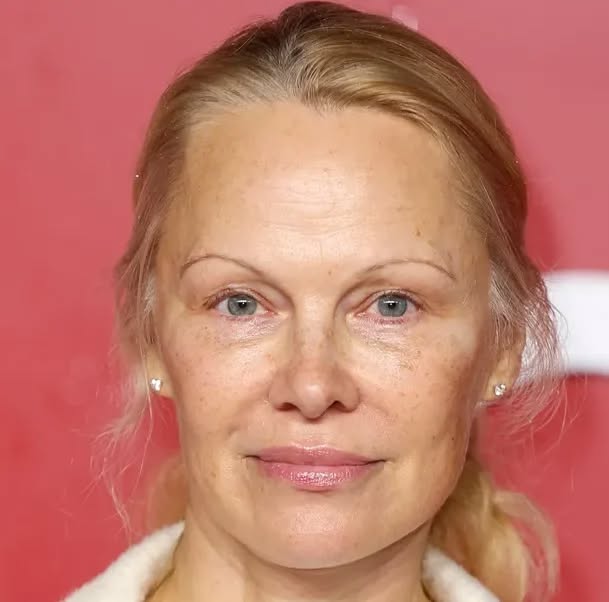Pamela Anderson has turned the page on her movie‑star life and retreated to the lush, windswept beauty of Vancouver Island, where she now calls her grandparents’ lovingly restored farmhouse home. In early 2024, the Baywatch icon quietly sold her sprawling Los Angeles estate for $11.8 million, opting instead for a return to her roots—and a life defined by simplicity, solitude, and the joyful chaos of caring for her five rescue dogs.
Her road to Hollywood stardom began in the most unlikely of places: a crowded football stadium in British Columbia, where a modeling scout spotted the fresh‑faced teenager cheering in the stands. Within months, Pamela was gracing magazine covers, landing roles on Home Improvement and then, in 1992, becoming a household name as the courageous lifeguard C.J. Parker on Baywatch. For more than a decade, she balanced blockbuster fame with highly publicized personal ups and downs—marriages to rock star Tommy Lee and later to Kid Rock, highly publicized legal battles, and nonstop tabloid coverage that often overshadowed her acting work.
Yet through it all, Pamela remained steadfast in her belief that life was meant to be lived on her own terms. A passionate advocate for animal rights and environmental causes, she founded the Pamela Anderson Foundation in 2002, channeling her platform into campaigns against animal cruelty, factory farming, and ocean pollution. Over the years, she also became fascinated by sustainable architecture, collaborating with eco‑friendly builders to design energy‑efficient homes that blended luxury with a low carbon footprint.
When the time came to downsize, Pamela spurned the glitzy high‑rise condos and gated mansions of Los Angeles. Instead, she headed back to the land where she first learned the rhythms of nature. The farmhouse she now inhabits belonged to her grandparents—stalwart pioneers who first homesteaded on Vancouver Island in the 1950s. With its original timber beams, wide plank floors, and wraparound porch overlooking fields of ferns and wildflowers, the house held a thousand childhood memories. Over several months, Pamela oversaw a careful renovation: reclaimed‑wood paneling in the kitchen, passive‑solar windows in the great room, and a green roof planted with native sedums.
Inside, the décor reflects her love of both rugged wilderness and gentle comfort. Hand‑woven rugs cover the oak floors. A wood‑burning stove stands ready for chilly coastal nights. Portraits of rescued animals line the walls, mingling with framed photographs of her early years on Baywatch. But it is the five dogs—two German shepherd mixes, a Labrador retriever, and two smaller rescues—that truly make the house come alive. Each morning, Pamela rises before dawn to feed them, then heads out on a quiet forest trail for a brisk walk, letting the misty air sharpen her senses. “There’s a kind of meditation in those silent woods,” she says. “It’s where I heal.”
Her choice to forego makeup these days is another deliberate act of liberation. After decades under harsh studio lights and relentless scrutiny, she now greets the mirror bare‑faced, embracing every laugh line and freckle. “This is who I am,” she explains. “I’ve lived a thousand lives already. Now I want to inhabit this one fully.”
Pamela’s days here follow an unhurried rhythm. Mornings are for walking the dogs and tending to a small vegetable garden she planted alongside local gardeners. Afternoons find her in a cozy study overlooking the orchard, drafting letters for her foundation or researching new wildlife‑conservation initiatives. She still travels—last spring she flew to Europe to speak at an animal‑welfare conference—but always returns to the farmhouse, where a welcome fire and eager tails greet her at the door.
In evening gatherings, she occasionally hosts a few friends—artists, activists, and former castmates—around a long farmhouse table. They share rustic meals made with local ingredients: freshly caught salmon, kale from her garden, and wild mushrooms foraged from nearby woods. Conversation drifts from the latest environmental legislation to memories of those long Baywatch shoots under the Californian sun.
For Pamela, this chapter is not a retreat but a homecoming—a chance to savor life without the glare of paparazzi or the pressure to perform. In the quiet hum of bees among her wildflower meadow, in the grateful nudges of her five dogs, she has rediscovered a peace that fame once obscured. “I sold a mansion in L.A.,” she reflects, “but I gained everything I really needed: space to breathe, time to think, and a house full of love.”
And so, in the gentle hush of Vancouver Island’s coastal forests, Pamela Anderson has found her true sanctuary—a place where every sunrise is a gift, every tree tells a story, and every paw print on the worn floorboards reminds her that the most meaningful wealth is measured not in dollars, but in the quiet moments that take our breath away.



